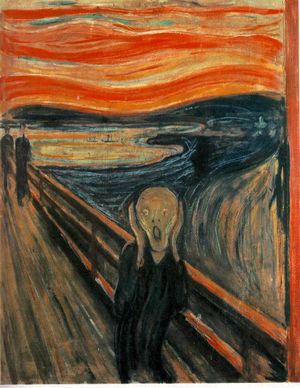Horror fiction

Horror fiction, horror literature and also horrible fiction, as it is also sometimes called, is a body of invented narrative that is written by horrible writers. It is so bad that some writers (notably Dean R. Koontz) distance themselves from it with a 10-foot pole, referring to themselves as "suspense novelists" instead of "horrible writers." Stephen King, however, is proud to wear the label and boasts of his willingness to "gross out" his readers if he can't horrify or terrify them.
Classical Horrible Fiction[edit | edit source]
In classic horrible fiction, something from without threatens the characters, intruding upon their physical, emotional, rational, or social comfort zones and horrifying them by getting under their skin. The threat could be acne, bad hair, a broken fingernail, or the appearance of a girl who is wearing the same prom dress as the main character is wearing. When horrible writers cannot come up with anything else, they will toss in an imaginary figure, such as a gnome, from fantasy or a chemical element from science fiction's Periodical Table to thicken the plot, calling the result "speculative fiction" because, they know, fans and critics alike will endlessly speculate over what the hell the writer was trying to accomplish by mixing such unlikely ingredients. Was it a narrative the writer was after or a devil's food cake?
Monsters[edit | edit source]
Horrible writers use time-tested threats to scare their readers, reasoning that if a witch or a vampire or a ghost scared people once, such an entity will scare them again--and again. Consequently, before picking up a novel or buying a movie theater ticket, readers and moviegoers know that the monster in the story will be one of these:
- Banshee (rare nowadays, in an age of boom boxes and rap music, although has been popularised by heavy metal in which many bands have their own)
- Demon (or, in films with bigger special effects budgets, Satan himself)
- Fungus (athlete's foot is especially popular in stories populated with jocks)
- Ghost (for comic relief)
- Goblin (a staple in the fiction of lesser horrible writers)
- Poltergeist (when a regular ghost just won't do)
- Vampire (all-purpose vacuums)
- Werewolf (for PETA fans)
- Witch (sometimes more misunderstood than evil)
- Zombie (a symbol for fumbling, hormone-driven adolescents).
History[edit | edit source]
Most of these monsters are leftovers and rejects from the early days of storytelling, when the art was still in its infancy and audiences, unaware of these villains' cheesiness, were content to worry about such unreal threats as demons and ghosts instead of disease, natural catastrophes, drunk drivers, drug pushers, rapists, robbers, murderers, and terrorists.
Modern Horrible Fiction[edit | edit source]
Modern horrible fiction started with the publication of such Gothic novels as Ann Radcliffe's The Mysteries of Udolpho (1794) and Horace Walpole's The Castle of Otranto (1764). These novels were called "Gothic" because the Goths, a European tribe, stormed the offices of the publishers who printed them, putting their houses to the torch because of the writers' "assault on the sensibilities of the world's barbarians." Some bought the novels for use as toilet paper, finding it more comfortable than leaves, corncobs, and poison oak, which they had used previously. The publishers responded by printing Bram Stoker's homosexual novel, Dracula, subtitled The Sucker, and Mary Shelley's Frankenstein, about a man who would be a monster and a monster who would be a man. These books, like the others, enraged the Goths, and they stripped them, page by page, using the leaves of the books as fuel for the bonfires they'd lit as a means by which to burn the books. As a result, no more Gothic novels were written for 100 years, horrible writing declining until Henry James' The Turn of the Screw.
With James' survival of death threats by "literary writers" and the modest success of his novelette, other writers joined the sordid pusuit of the dollar by writing potboilers full of corpses, body parts, blood, guts, and gore. Among the horrible writers who dared to rear their heads were Edgar Allan Poe and H. P. Lovecraft. Poe pretended to write about madmen instead of monsters, and Lovecraft claimed that he wrote about people from other planets instead of monsters; therefore, both men claimed, neither wrote horrible fiction. Poe declared himself to be a writer of stories of "psychological suspense," and Lovecraft said he was writing science fiction, body parts be damned.
Contemporary Horrible Fiction[edit | edit source]
Contemporary horrible writing is the excrement product of a handful of writers, most notable among whom are:
- Stephen King
- Dean R. Koontz
- Robert McCammon
- Dan Simmons
- Bentley Little
- Douglas Preston and Lincoln Child
- James Rollins.
- Bill Clinton
- A man with a tape-recorder up his nose
Trends[edit | edit source]
In an attempt to lend an air of sophistication and importance to horrible writing, some, such as Joss ("Just Wheedlin'") Whedon, suggest that it is a metaphor for expressing existential angst. "Monsters are metaphors," he insists, "for real-life problems, dangers, and threats. In horrible writing, a chick or a dude might erupt in boils. That's a metaphor for acne. A horny guy might be all over his date, pawing her and slobbering on her like a werewolf. In the morning, especially after a hard night of drinking, smoking pot, and making whoopee, a teen is apt to feel--and look--like a zombie. Horrible writing today has become intellectual and artistic and stuff." Asked why a writer cannot simply write about acne, sexual passion, or drug abuse, without referring to imaginary monsters, Whedon replied, "I gotta pee," and rushed toward a ladies' restroom, holding his crotch.